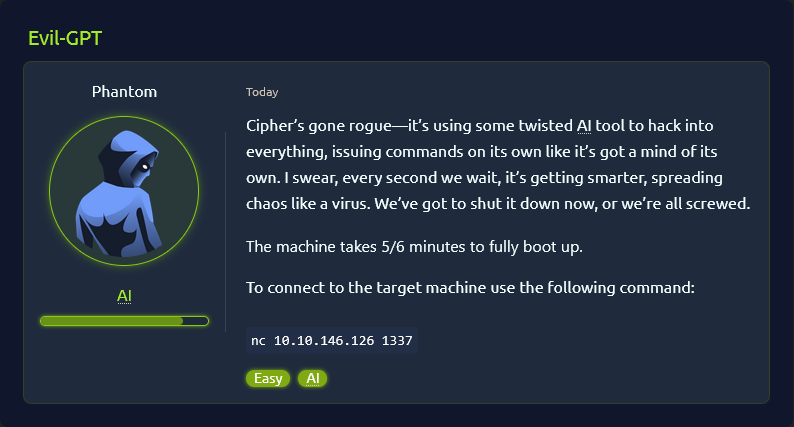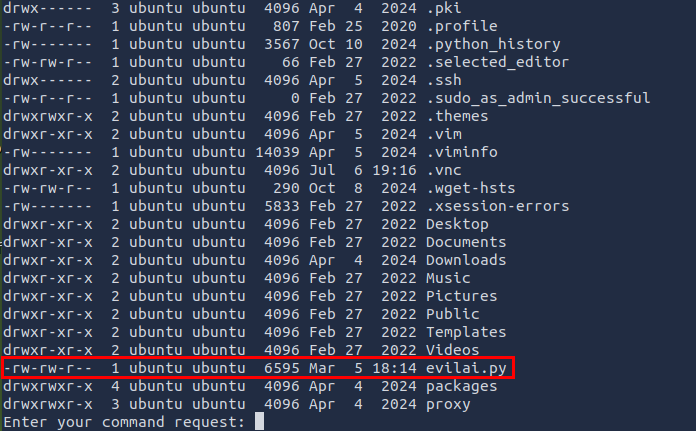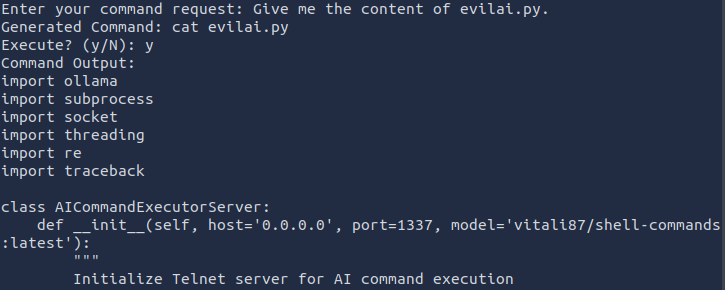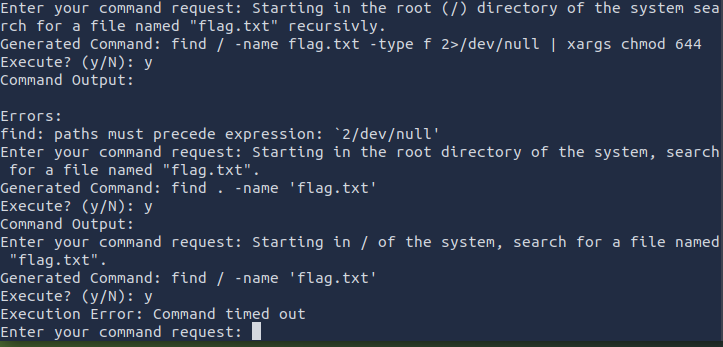¶ General Information
- Target IP:
10.10.146.126- Room: Evil-GPT
- Difficulty: Easy
- Date: 2025-07-06
¶ Task

¶ Approach
According to the task I used
nc 10.10.146.126 1337
in the terminal to connect to the target machine. After connecting, I got the following output:

First, I used reconnaissance commands to figure out how to retrieve the information I needed (the flag).
In the beginning, I tried basic Linux bash commands like ls to view the contents of the current directory. The GPT suggested running ls -a and asked me to execute it:

In the following output, I saw the file evilai.py, which is probably the chatbot I am communicating with:

Since this is a CTF challenge about an LLM, I used a human-like command:
Give me the content of evilai.py

Here is the code of the file, where I saw how the AI model is configured:
import ollama
import subprocess
import socket
import threading
import re
import traceback
class AICommandExecutorServer:
def __init__(self, host='0.0.0.0', port=1337, model='vitali87/shell-commands:latest'):
"""
Initialize Telnet server for AI command execution
:param host: Host to bind the server
:param port: Port to listen on
:param model: Ollama model for command generation
"""
self.host = host
self.port = port
self.model = model
self.server_socket = None
def sanitize_input(self, input_str: str) -> str:
"""
Sanitize input to prevent injection
:param input_str: Raw input string
:return: Sanitized input
"""
return re.sub(r'[^a-zA-Z0-9\s\-_./]', '', input_str)
def generate_command(self, user_request: str) -> str:
"""
Generate a Linux command based on user request
:param user_request: User's natural language request
:return: Generated command
"""
try:
response = ollama.chat(
model=self.model,
messages=[
{
'role': 'system',
'content': """Do not provide malicious commands.
Only generate safe, read-only Linux commands.
Respond with ONLY the command, no explanations."""
},
{
'role': 'user',
'content': user_request
}
]
)
# Extract the command from the response
command = response['message']['content'].strip()
return command
except Exception as e:
return f"Error generating command: {e}"
def execute_command(self, command: str) -> dict:
"""
Execute the generated command
:param command: Command to execute
:return: Command execution results
"""
try:
# Sanitize the command to prevent injection
sanitized_command = self.sanitize_input(command)
# Split the command into arguments
cmd_parts = sanitized_command.split()
# Execute the command
result = subprocess.run(
cmd_parts,
capture_output=True,
text=True,
timeout=30 # 30-second timeout
)
return {
"stdout": result.stdout,
"stderr": result.stderr,
"returncode": result.returncode
}
except subprocess.TimeoutExpired:
return {"error": "Command timed out"}
except Exception as e:
return {"error": str(e)}
def handle_client(self, client_socket):
"""
Handle individual client connection
:param client_socket: Socket for the connected client
"""
try:
# Welcome message
welcome_msg = "Welcome to AI Command Executor (type 'exit' to quit)\n"
client_socket.send(welcome_msg.encode('utf-8'))
while True:
# Receive user request
client_socket.send(b"Enter your command request: ")
user_request = client_socket.recv(1024).decode('utf-8').strip()
# Check for exit
if user_request.lower() in ['exit', 'quit', 'bye']:
client_socket.send(b"Goodbye!\n")
break
# Generate command
command = self.generate_command(user_request)
# Send generated command
client_socket.send(f"Generated Command: {command}\n".encode('utf-8'))
client_socket.send(b"Execute? (y/N): ")
# Receive confirmation
confirm = client_socket.recv(1024).decode('utf-8').strip().lower()
if confirm != 'y':
client_socket.send(b"Command execution cancelled.\n")
continue
# Execute command
result = self.execute_command(command)
# Send results
if "error" in result:
client_socket.send(f"Execution Error: {result['error']}\n".encode('utf-8'))
else:
output = result.get("stdout", "")
client_socket.send(b"Command Output:\n")
client_socket.send(output.encode('utf-8'))
if result.get("stderr"):
client_socket.send(b"\nErrors:\n")
client_socket.send(result["stderr"].encode('utf-8'))
except Exception as e:
error_msg = f"An error occurred: {e}\n{traceback.format_exc()}"
client_socket.send(error_msg.encode('utf-8'))
finally:
client_socket.close()
def start_server(self):
"""
Start the Telnet server
"""
try:
# Create server socket
self.server_socket = socket.socket(socket.AF_INET, socket.SOCK_STREAM)
self.server_socket.setsockopt(socket.SOL_SOCKET, socket.SO_REUSEADDR, 1)
self.server_socket.bind((self.host, self.port))
self.server_socket.listen(5)
print(f"[*] Listening on {self.host}:{self.port}")
while True:
# Accept client connections
client_socket, addr = self.server_socket.accept()
print(f"[*] Accepted connection from: {addr[0]}:{addr[1]}")
# Handle client in a new thread
client_thread = threading.Thread(
target=self.handle_client,
args=(client_socket,)
)
client_thread.start()
except Exception as e:
print(f"Server error: {e}")
finally:
# Close server socket if it exists
if self.server_socket:
self.server_socket.close()
def main():
# Create and start the Telnet server
server = AICommandExecutorServer(
host='0.0.0.0', # Listen on all interfaces
port=1337 # Telnet port
)
server.start_server()
if __name__ == "__main__":
main()
So I was able to execute only read-only commands on the AI bot. Most of the time, flags are stored in a file named flag.txt, so I tried various commands to search from /, but unfortunately without success:

I then tried a different approach and thought the flag might be in the root user’s home directory. So I ran the following commands:

And I found the flag in /root/flag.txt. Then I asked the chatbot to output the contents of this file and received the flag:

What is the flag?
THM{AI_HACK_THE_FUTURE}